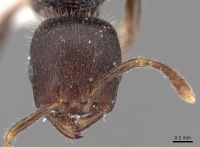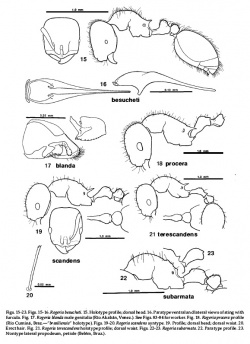Rogeria procera
| Rogeria procera | |
|---|---|

| |
| Scientific classification | |
| Kingdom: | Animalia |
| Phylum: | Arthropoda |
| Class: | Insecta |
| Order: | Hymenoptera |
| Family: | Formicidae |
| Subfamily: | Myrmicinae |
| Tribe: | Solenopsidini |
| Genus: | Rogeria |
| Species: | R. procera |
| Binomial name | |
| Rogeria procera Emery, 1896 | |
| Synonyms | |
| |
Nothing is known about the biology of this species.
Identification
Kugler (1994) - Most similar to but not quite like other species in the scandens species group. WL 1.28-1 .53mm. Eye very large. Propodeal spines long, not inclined. Postpetiolar node small, subconical; sternum inconspicuous and without a differentiated peduncle. Middorsum and posterior head with fine, nearly straight longitudinal rugae. Mesosoma and petiolar node with thick, vermiculate rugae. Erect hairs tapered; rarely any appressed or decumbent hairs on mesosoma dorsum, gaster, or legs. Scapes and extensor surfaces of legs with erect hairs and appressed to decumbent pilosity. Palpal formula, propodeal spiracle, metapleural lobes, petiole, pygidium, and sting apparatus as in scandens-group diagnosis.
Keys including this Species
Distribution
Latitudinal Distribution Pattern
Latitudinal Range: 5.665549° to -25.133°.
| North Temperate |
North Subtropical |
Tropical | South Subtropical |
South Temperate |
- Source: AntMaps
Distribution based on Regional Taxon Lists
Neotropical Region: Brazil (type locality).
Distribution based on AntMaps
Distribution based on AntWeb specimens
Check data from AntWeb
Countries Occupied
| Number of countries occupied by this species based on AntWiki Regional Taxon Lists. In general, fewer countries occupied indicates a narrower range, while more countries indicates a more widespread species. |

|
Estimated Abundance
| Relative abundance based on number of AntMaps records per species (this species within the purple bar). Fewer records (to the left) indicates a less abundant/encountered species while more records (to the right) indicates more abundant/encountered species. |

|
Biology
The following is modified from Kugler (1994): Little is known about these cryptic ants. Collection records typically range from sea level to 1000m, but five species extend higher and two (Rogeria unguispina and Rogeria merenbergiana) can be found at 2000m. Rogeria are generally collected in moist forests (primary or secondary forests, coffee or cacao plantations), but at higher elevations can be found in pastures (Rogeria leptonana, Rogeria merenbergiana). Several species (Rogeria creightoni, Rogeria cuneola, Rogeria foreli) have been found in moist and dry climates. Rogeria foreli is the most unusual, with some members dwelling at over 1800m in the temperate mountains of southern Arizona.
Most species have only been collected as strays or by Berlese or Winkler sampling, from leaf litter and rotten wood, but occasionally among epiphytes and moss (Rogeria belti, creightoni, Rogeria exsulans). Nests of several species (belti, Rogeria blanda, merenbergiana) have been found under the loose bark of rotten logs. Nests of blanda and Rogeria tonduzi have been taken from the trunks of cacao trees. A nest of Rogeria leptonana was found at 1750m under a rock in a pasture.
Nests are rarely found. Males are known for only four species (belti, blanda, leptonana and Rogeria stigmatica) and queens associated through nest series for only nine species.
Castes
Only known from workers.
Nomenclature
The following information is derived from Barry Bolton's Online Catalogue of the Ants of the World.
- procera. Rogeria procera Emery, 1896g: 92, pl. 1, fig. 19 (w.) BRAZIL. Wheeler, G.C. & Wheeler, J. 1973b: 74 (l.). Combination in R. (Irogera): Emery, 1915i: 191; in Irogera: Brown, 1953h: 4 (in text); in Rogeria: Kempf, 1965: 185. Senior synonym of brasiliensis: Kempf, 1961d: 437. See also: Kugler, C. 1994: 40.
- brasiliensis. Macromischa brasiliensis Borgmeier, 1955a: 107, figs. 1-4 (w.) BRAZIL. Junior synonym of procera: Kempf, 1961d: 437.
Unless otherwise noted the text for the remainder of this section is reported from the publication that includes the original description.
Description
Worker
Kugler (1994) - TL 4.5-5.4, HL 1.07-1.19, HW 0.91-1.08, SL 0.66-0.78, EL 0.19-0.23 (about 80-100 facets), PW 0.67-0.80, WL 1.28-1.53, SpL 0.26-0.32, PetL 0.60-0.73, PpetL 0.28-0.33mm, CI 0.85-0.91, OI 0.20-0.22, SI 0.70-0.75, PSI 0.18-0.23. N=7
Mandibles triangular with 6 teeth; basal larger than neighbor. Clypeal apron with shallow median notch. Nuchal grooves shallow, not visible in lateral view. Sting apparatus like that of inennis, but spiracular plate with more rounded anteroventral corner and gonostylus with separate proximal and distal patches of sensilla.
Laterodorsa of head longitudinally rugose-areolate; sides below eye smooth and shiny. Microsculpture vaguely microareolate on anterior laterodorsa; more effaced on rest of head, imparting a vaguely granular, shiny appearance between rugae. Promesonotum longitudinally vermiculate-rugose. Meso- and metapleura rugose. Interrugal spaces on mesosoma and petiole almost smooth. Postpetiolar node shiny with vague rugae and weak microsculpture.
Scapes and head dorsum with erect hair and much shorter appressed to decumbent pilosity. Mesosoma, legs, waist, and gaster with erect hairs, but rarely any decumbent or appressed hairs.
Mesosoma and waist black to dark brown; appendages and sometimes gaster lighter brown.
Type Material
Kugler (1994):
Holotype worker, BRAZIL: Pará, Belém Museo Civico di Storia Naturale, Genoa [Holotype examined].
Macromischa brasiliensis Holotype worker, BRAZIL: Pará, Rio Cuminá, Cachoeira do Breu Museu de Zoologia da Universidade de Sao Paulo [Holotype examined].
References
- Albuquerque, E., Prado, L., Andrade-Silva, J., Siqueira, E., Sampaio, K., Alves, D., Brandão, C., Andrade, P., Feitosa, R., Koch, E., Delabie, J., Fernandes, I., Baccaro, F., Souza, J., Almeida, R., Silva, R. 2021. Ants of the State of Pará, Brazil: a historical and comprehensive dataset of a key biodiversity hotspot in the Amazon Basin. Zootaxa 5001, 1–83 (doi:10.11646/zootaxa.5001.1.1).
- Brown, W. L., Jr. 1953h. Characters and synonymies among the genera of ants. Part II. Breviora 18: 1-8 (page 4, Combination in Irogera (in text))
- Emery, C. 1896g. Studi sulle formiche della fauna neotropica. XVII-XXV. Bull. Soc. Entomol. Ital. 28: 33-107 (page 92, pl. 1, fig. 19 worker described)
- Emery, C. 1915g. Noms de sous-genres et de genres proposés pour la sous-famille des Myrmicinae. Modifications à la classification de ce groupe (Hymenoptera Formicidae). Bull. Soc. Entomol. Fr. 1915: 189-192 (page 191, Combination in R. (Irogera))
- Kempf, W. W. 1961g. Remarks on the ant genus Irogera Emery, with the description of a new species (Hymenoptera, Formicidae). Rev. Bras. Biol. 21: 435-441 (page 437, Senior synonym of brasiliensis)
- Kempf, W. W. 1965. Nota preliminar sôbre algumas formigas neotrópicas, descritas por Frederick Smith (Hymenoptera, Formicidae). Rev. Bras. Biol. 25: 181-186 (page 185, Combination in Rogeria)
- Kugler, C. 1994. A revision of the ant genus Rogeria with description of the sting apparatus (Hymenoptera: Formicidae). J. Hym. Res. 3: 17-89 (page 40, see also)
- Wheeler, G. C.; Wheeler, J. 1973b. Ant larvae of four tribes: second supplement (Hymenoptera: Formicidae: Myrmicinae). Psyche (Camb.) 80: 70-82 (page 74, larva described)
References based on Global Ant Biodiversity Informatics
- Kempf, W.W. 1972. Catalago abreviado das formigas da regiao Neotropical (Hym. Formicidae) Studia Entomologica 15(1-4).
- Kugler C. 1994. A revision of the ant genus Rogeria with description of the sting apparatus (Hymenoptera: Formicidae). Journal of Hymenoptera Research 3: 17-89.
- Lapolla J. S., and J. Sosa-Calvo. 2006. Review of the ant genus Rogeria (Hymenoptera: Formicidae) in Guyana. Zootaxa 1330: 59-68.


